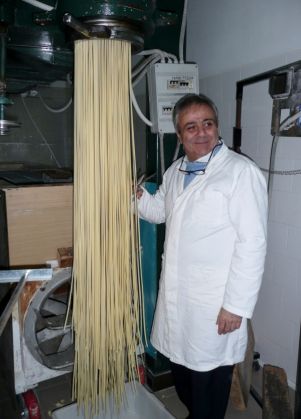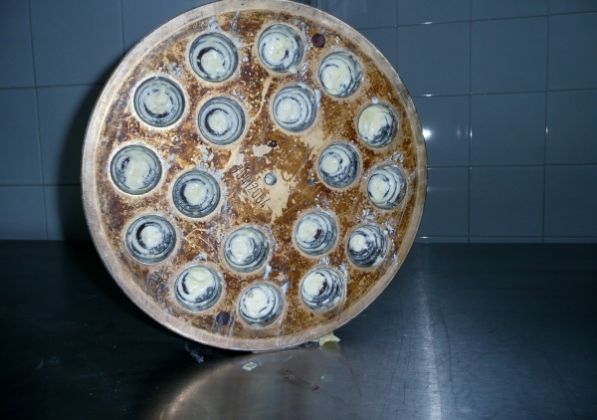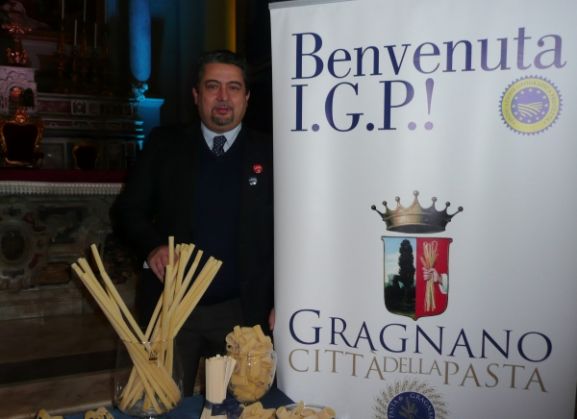Our second feature on traditional Italian crafts
The Amalfi Coast is one of Italy's most popular tourist spots, and yet few visitors venture from the coast to explore the craggy Lattari mountains that rise above the string of little towns and inlets that face the tranquil Gulf of Salerno. Thanks to their inaccessibility, however, these mountains have been preserved virtually uncontaminated, cloaked in spontaneous vegetation, Mediterranean scrub, woods and springs.
It was the presence of abundant springs of pure mountain water and an almost constant soft sea breeze that favoured the creation of the pasta-making industry of the small hillside town of Gragnano, perched on the slopes above Amalfi. Morning and evening, an east-west wind blows through the main street where great sheets of pasta used to be hung outside on rods to let them dry in the air. This picturesque scene no longer exists, of course. The pasta is now dried indoors to respect modern hygienic requirements but Gragnano is still the “City of Pasta”, leader of what is known as the “White Art” of pasta-making.
In the second half of the 19th century, during its period of maximum glory, the pasta industry of Gragnano was so famous that the Bourbon rulers of Naples built a railway connecting the town to Castellammare di Stabia. It was a continuation of Italy's very first railway line, constructed in 1839 to link Naples to Portici, and the principal purpose of the extension was to facilitate the swift and easy transportation of pasta to the Campania capital. The town identified itself so closely with pasta production, in fact, that the coat of arms features a fist clasping a sheaf of corn.
The competition of cheaper industrial-made pasta hit the industry badly in the 20th century and the Irpinia earthquake of 1980 dealt another blow. The former 100 Gragnano pasta manufacturers of the golden age shrank. The survivors, however, fought back, combining their forces to form the Cooperativa Pastai Gragnano and continue the time-honoured father-to-son tradition. The cooperative has now developed into the Gragnano Città della Pasta Consortium of eight family-run pasta factories that collectively churn out an astonishing 9,000 quintals of pasta each day. 80 per cent of this is exported.
Giuseppe Di Martino, owner of the Pastificio Di Martino and Dei Campi and president of the consortium says: “Gragnano produces 14% of Italy's pasta export market. Every day our pasta reaches 10 million gourmet consumers all over the world.”
Gragnano pasta, in fact, is a gourmet product. The pasta manufacturers made the wise decision to aim for superior quality, using only the best durum wheat grown in Puglia, Basilicata and Abruzzo mixed with the water of their mountain springs and fed through special bronze moulds. The trafilature in bronzo process gives Gragnano pasta not only its unique shapes but also ensures a perfect al dente consistency in cooking. There are over 40 different forms, some combined with natural ingredients, such as lemon, chillies, porcini mushrooms, sepia ink and so on. The classics, however, remain the pacchero, a large, thick tube invented in Gragnano, the fusilli that were traditionally rolled round a knitting needle and the caccavella, that claims to be the world's biggest pasta shape. The pasta makers are not content to stick rigidly to tradition and are constantly inventing new shapes to intrigue the consumer. Many are exclusive and protected by copyright. Another important factor is the drying process, which is slow and at a low temperature. The traditional maccheroni or pasta lunga (what we call spaghetti) come out of the mixing machine in long ribbons that are cut with sheers and draped over steel rods. The shorter forms are dried on trays.
The Consortium's far-sightedness was awarded with IGP status (a protected food product from a specific geographic area recognised by the EU) in December 2013 – the first pasta product to join the list of Italy's 261 registered IGP foods. The event was celebrated in the town with a grand Pasta Fair in the main piazza and a formal presentation in the historic Church of Corpus Domini – notable for its splendid 18th-century silk canopy that covers the entire 400-sqm ceiling of the nave and a throw-back to the age when the town was known, not only for its flour and maccheroni, but also for silk and leather production.
“IGP recognition means that no other manufacturer in the European community can use our name or imitate our pasta. Our next aim is to extend this exclusive recognition to the rest of the world,” De Martino says. “IGP status also means quality control with regular checks by state inspectors.” He points out that Italy controls and guarantees its food products more than any other country.
A trip to the town is not complete without a visit to the Valley of the Mills, where once some 30 mediaeval water mills stood on the banks of the Vernotico stream, fed by spring water channelled through a system of acqueducts. Up until the mid 19th century these mills provided the power to grind the flour supply, not only for Gragnano, but also for all the bakers of the city of Naples. Electricity silenced the old mill-wheels forever. Nine survive as picturesque ruins covered in trailing undergrowth. The winding road through the narrow valley leads to the old Romanesque Church of the Assumption, declared a national monument in 1927. At Christmas, the valley revives thanks to a spectacular hand-made Nativity scene set up under the arches of the 17th-century bridge leading into the valley, which draws droves of visitors each year. In the true Neapolitan tradition, the Christmas crib reflects features of everyday life in the 17th-18th century and it goes without saying that it includes the baker and the pasta maker.
For information Soc. Cons. Gragnano Città della Pasta, www.pastadigragnanoigp.it.























